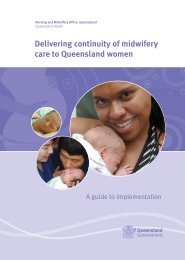Gold Coast Birth Centre - Queensland Centre for Mothers & Babies
Gold Coast Birth Centre - Queensland Centre for Mothers & Babies
Gold Coast Birth Centre - Queensland Centre for Mothers & Babies
You also want an ePaper? Increase the reach of your titles
YUMPU automatically turns print PDFs into web optimized ePapers that Google loves.
Introduction<br />
Background<br />
The <strong>Queensland</strong> <strong>Centre</strong> <strong>for</strong> <strong>Mothers</strong> & <strong>Babies</strong> (QCMB) is an independent research centre based at The University of <strong>Queensland</strong>.<br />
The <strong>Centre</strong> was funded by the <strong>Queensland</strong> Government in 2009, in response to the findings of the Review of Maternity Services<br />
in <strong>Queensland</strong> (Hirst, 2005). A key strategic direction of the <strong>Centre</strong> is to generate and disseminate evidence that enhances the<br />
capacity of care providers and policy-makers to understand, and respond to, the requirements of women accessing maternity<br />
care.<br />
To meet this goal, the QCMB conducts population surveys to understand the maternity care experiences of women in<br />
<strong>Queensland</strong>. The surveys ask women about the care and support they received be<strong>for</strong>e, during and after the birth of their most<br />
recent baby. The surveys are an important way of collecting women’s perspectives on the quality of maternity services provided<br />
in <strong>Queensland</strong>.<br />
The 2010 Having a Baby in <strong>Queensland</strong> Survey<br />
In 2010, all women who had a live birth in <strong>Queensland</strong> between February 1 and May 30, received a Having a Baby in <strong>Queensland</strong><br />
Survey package in the mail when their baby was 4 to 5 months old. Three modes of survey completion were available to women:<br />
paper, online or telephone. Women were also given the option to complete the survey in a language other than English over the<br />
telephone, with a translator and a female interviewer (see Miller et al., 2011 <strong>for</strong> more in<strong>for</strong>mation).<br />
Data collected in the Having a Baby in <strong>Queensland</strong> Survey Program are used in several ways. Data are provided directly to<br />
<strong>Queensland</strong> Health in a comprehensive report outlining key survey findings. This report highlights differences in consumer<br />
experiences based on health sector, parity, and rurality of residence, in addition to providing recommendations <strong>for</strong> improved<br />
service delivery. An electronic copy of the report is available at www.qcmb.org.au/reports. Data are also presented in <strong>Birth</strong>place,<br />
an online consumer guide to all birthing facilities in <strong>Queensland</strong> (www.havingababy.org.au/birthplace) 1 . <strong>Birth</strong>place was developed<br />
to support women and their families to choose a facility <strong>for</strong> birth and/or to know what to expect from their chosen birthing facility.<br />
<strong>Birth</strong>place can also be used by care providers and others <strong>for</strong> quality improvement purposes, and some facility-level data not<br />
included in this report can be viewed in <strong>Birth</strong>place.<br />
About This Report<br />
This report presents the findings of the 2010 Having a Baby in <strong>Queensland</strong> Survey at an individual facility level. The report was<br />
developed as a means of providing feedback on the experiences of consumers to facilities, particularly by identifying areas of<br />
strength and opportunities <strong>for</strong> improvement in service delivery. We have selected 22 key per<strong>for</strong>mance indicators to highlight the<br />
care provided to women in each geographic region in <strong>Queensland</strong>. Rather than reporting on clinical indicators that may differ<br />
according to the case mix in a particular facility, indicators were selected based on their applicability to all women.<br />
On each per<strong>for</strong>mance indicator we provide the proportion of respondents from each birth facility within that region who reported<br />
receiving ‘gold standard care’. <strong>Gold</strong> standard care is always represented by the red bars in the graph. For some indicators (e.g.<br />
being well cared <strong>for</strong>, being treated with respect), gold standard care is achieved where women give their care the highest<br />
evaluation possible. Where data are measured on a continuous scale of 1 (lowest) to 5 (highest), gold standard care is achieved<br />
<strong>for</strong> all women who report ‘5’. Where data are measured as a proportion of time (e.g. ‘none of the time’, ‘some of the time’, ‘all of<br />
the time’), gold standard care is achieved <strong>for</strong> all women who report ‘all of the time’. We report on gold standard care as it is<br />
expected that care providers would strive <strong>for</strong> all women in the birth facility to receive the highest level of care possible <strong>for</strong> such<br />
indicators.<br />
For other indicators (e.g. timing of booking visit, postnatal contact), gold standard care is achieved where women report an<br />
experience that is consistent with current <strong>Queensland</strong> Health policies and guidelines and/or research evidence on best care<br />
practices. Again, we report on gold standard care as it is expected that care providers would strive <strong>for</strong> all women in the birth<br />
facility to report care consistent with current policies, guidelines and research evidence.<br />
1<br />
In some instances, the figures presented in this report may differ by 1% from those reported in <strong>Birth</strong>place due to differential approaches <strong>for</strong><br />
rounding decimal places between the two systems.<br />
6
















